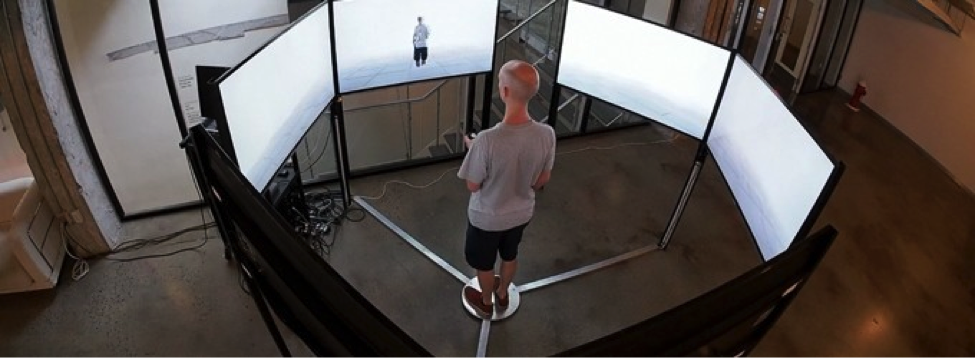To say the way we interact with media and information has changed in the seven-hundred or so years since the invention of the printing press would be like saying the sky is blue. It’s plainly obvious.
From reading printed text, to scrolling through it with cursors and mouse pointers, to being able to physically pull and pinch content larger or smaller with touch-screens, information is now literally at our fingertips.
It’s gotten to the point that children born in this generation pinch and pull at books and are surprised when the text doesn’t shrink or enlarge.
As technology progresses, the goal is more usability, streamlining the user interface (UI), and making the user experience (UX) more intuitive, as if we’re connected to the very media we’re processing.
Think of how much easier it is to swipe through images than it was to point at them with a mouse, or how much easier a mouse is on a GUI than navigating the bare command line of an operating system.
New tech and applications are constantly being created by developers and companies trying to push UI forward to that next big step in usability.
Here are a few examples of those emerging technologies to pay attention to:
THAW
MIT Media Lab has come out with an interface called
THAW, which allows multiple screens to share the same experience.
Say you had a file open on your smartphone and you wanted it on your desktop. Usually, you’d have to use a menu to select the file folder and move it between devices manually, either through a wi-fi or cable connection, or via email or cloud storage acting as a bridge between devices.
THAW does away with all this.
A color grid is placed on the computer monitor, which a smartphone’s camera lens can detect, letting it know what part it’s hovering over, effectively acting like a mouse cursor.
This allows objects to “move” from smartphone to computer screen seamlessly upon detection.
A Super Mario Bros.-like game demo was developed by Sang-won Leigh which works with THAW technology to allow the transfer of the virtual avatar in between devices, and for the smartphone to affect obstacles in the video game level (slowing down or speeding them up).
Check out a demo of it in the video below:
It’s a novelty right now, but imagine the same device to device instant detection and transfer applied to music files, photographs, or office files with a flick of a finger.
The inFORM
A separate team at MIT previously came out with a tabletop interface called
the inFORM, which is a dynamic shape display that can sense a user’s physical touch and translate it to another person remotely via a hacked Microsoft Kinect sensor and a bed of flattened pins that take whatever shape they detect.
Check it out below:
This tabletop computer interface doesn’t just display images, but shapes as well, reintroducing tactility to the web.
In project member Daniel Leithinger’s words, “Humans have evolved to interact physically with our environments, but in the 21st century, we’re missing out on all of this tactile sensation that’s meant to guide us.”
The inFORM project seeks to bring some of that back.
The Drawing Space

In the same fashion that the inFORM seeks to connect two people through the internet in a more personal way, The Society of Technological Arts in Montréal has created The Drawing Space.
Using another Kinect hack, Luc Courchesne and his team have used three Kinects in a circle to capture images of a figure in the middle, breaking down points of light and building them back up onscreen in order to transmit their full 3D image onto the web, with all others hooked up to similar rigs.
Six screens surround the person in the middle of one rig, allowing a 360° view of a wide open digital space which multiple people all over the world can coexist in digitally, provided they’re connected to the same devices.
Users can then use their smartphones to affect the space around them, drawing shapes, picking up blocks, and even knocking them down.
Michaelangelo Yambao, on hand to demonstrate the installation at Toronto DigiFest, said that the basic proof of concept could be developed to eventually have entire built-in cityscapes simulated in the digital environment, potentially allowing international meet ups, business or creative studio meetings remotely, with each individual collaboratively affecting their shared digital space.
As Courchesne succinctly put it, “It would allow shared presences between fixed, remote locations, enabling two people to look out at, and interact with, the same virtual horizon, despite great distances.”
Ideum’s PCT Tables
The software company Ideum is experimenting with a way to bring all of these ideas to the workplace with
projected capacitive touch (or PCT) tables which are entire desks outfitted with computer technologies.
This allows everyday objects (with capacitive/conductive materials) like special sticky pads or keyboards to interact with the larger desk computing device (tapping on a sticky pad for example would activate a virtual notepad).
Check it out below:
Similar to THAW, the interface would allow files to be transferred from devices on the PCT table with a finger swipe.
Jim Spadaccini of Ideum is embracing touchscreen cloud-connected convenience while attempting to preserve the tangibility of the physical.
A day at the office would definitely be a lot more fun with these things in the cubicles.
